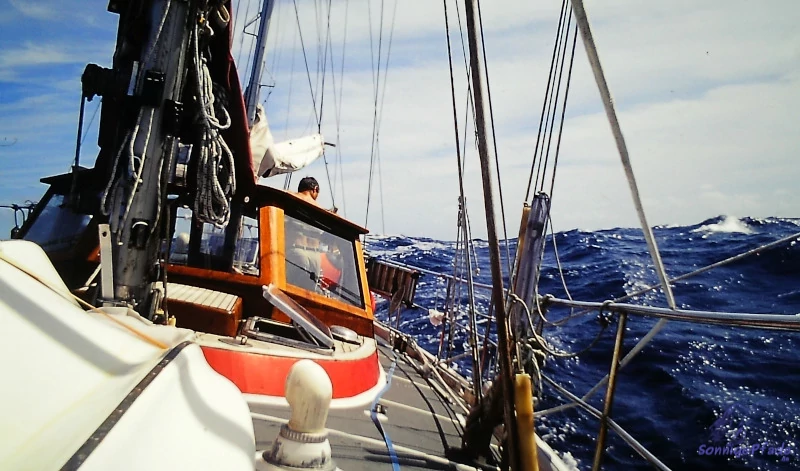
This is not the way it should go on if possible. Snowflakes are dancing around me. I sit on the scaffolding at a farmhouse near Rudolstadt in Thuringia and scrape around the half-timbered house with the wire brush. In June a family friend of mine had called me. They bought this part of the farm and started to renovate it. But the work is dragging on. The woman is challenged as an architect with the construction planning and in addition she has to take care of the daughter. The man will soon begin his legal clerkship to be able to work as a teacher in the future – and is therefore dropped out completely. On the building site, nothing is really going well, the own work is progressing slower than planned. They asked me if I had some time and could help. Well, I could do something for 14 days. Loam construction, definitely exciting for me. So I went there, helped in the heat of June, which lasted until the end of August, with stamping clay walls, lining some compartments, roofing and sewage plant and a lot of small stuff… Two weeks have become almost 6 months and winter is coming now to the Thuringian Forest.
But fortunately the change is already in sight. Two days ago the longed-for, almost not expected email with the confirmation arrived. The day after tomorrow I will be sitting in the plane to Tenerife and afterwards we will set sail. The Atlantic calls. On to Tobago!
The Airbus plane from Leipzig circles the huge massif of the Teide summit and lands punctually in Tenerife South airport. On board are mainly package holidaymakers, a few winter hikers and – me. Somewhere here on the island I will meet my crew and go on board the Pronto. But now I first have to orientate and acclimatize. With others in a small space, I will experience this long enough during the next weeks. A little rest before the storm will do me good. I leave the airport area on foot, cross the island motorway and walk up the clayey bare foothills on the opposite side. Soon I find a quiet place in the incoming twilight. I sit down and watch the landing and taking off planes at the nearby airport for a while. Then I unroll my sleeping bag and lay down to sleep in one of the many erosion channels. The first night on an adventurous tour!
The next morning I walk back to the highway. There is a bus stop at the junction to the airport. It does not take long and a bus stops next to me, with destination „Intercambiador“. This is the big bus station in Santa Cruz. My backpack comes in downstairs and the friendly bus driver invites me with an inviting gesture to take a seat. We drive in northern direction, always along the east coast of the island. Anticipation, but also a certain respect rises in me. Soon I will be sailing along out there in the opposite direction on a small sailboat. A fascinating performance. After some time, the roads branch out more and more, the bus turns to a smaller feeder road that leads around a rock and down to the coast. Skyscrapers and closed streets appear and shortly afterwards we arrive at the modern bus station of Santa Cruz. We arrive at the upper level – a wide square with many bus lanes. Below it there are more floors with bus stops and a reception hall. From here I walk towards the city centre. The Marina Atlantico should be somewhere opposite the main square Plaza de Espania.
I stroll leisurely through the streets. I have never been to Tenerife and enjoy every minute of being here. My grandma once got a postcard from a friend in the 80s. She had fled the GDR (German Demokratic Republic – the former socialist East Germany) in the 50s because she belonged to a „bourgeois factory owner family“ and had a hard time in the Stalinist GDR. Now she spent the winter on Tenerife. The hotel skyscraper on the postcard wasn’t exactly a temptation, but the blue sky, the palm trees and the sunny beaches behind it burned deep into my GDR winter-fogged brain.
After a twenty minute walk and a small snack I reach the Plaza des Espania. And looking over the tangent highway I already see a dense tangle of masts. The way over there is a bit twisted, but a short time later I made it. A short call and Klaus, the skipper, comes over the jetty to pick me up.
The Pronto is a 15m steel ketch with a larger fixed superstructure on the midship, a less spacious cockpit aft and the owner’s cabin below the aft deck. My place will be the forward berth opposite the wash cell. There is even a double-deck distribution, although the upper double berth is still occupied. But the couple will get out tomorrow and won’t come with me across the Atlantic – enough space for me. Karsten, who has been on board since he left Hamburg in August, sleeps in the saloon. The pronto has been lying here since the beginning of November. A damage to the cooling system and a crack in the mainsail still had to be repaired. The latter has been taken care of, and the engine plumbers keep saying… „Manana„. Unfortunately this costs 1 or 2 more days of waiting. For me time to at least explore Santa Cruz a bit more and in the evening to get to know my crewmates better over a glass of vino tinto in the warm street restaurants.
Because I had already looked for possibilities in spring for a larger sailing trip and to gain sailing experience. Thereby, I got stuck at the Pronto, first I had aimed at the possibility from Porto up to Tenerife, but unfortunately I did not get a free place anymore. And now, after persistent asking, the possibility arose to take part in the „jump over the big pond“!
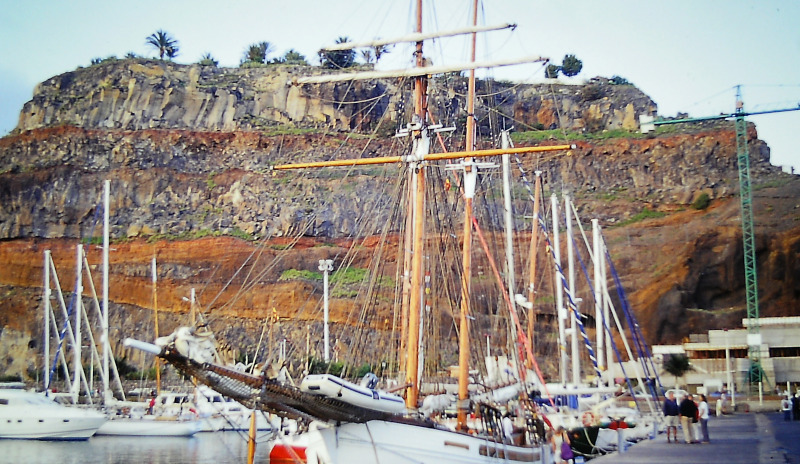
At last we’re off! Though first only the short trip from Santa Cruz de Tenerife to San Sebastian de la Gomera, but after all – out, blue water! The lines are loose, the Pronto manoeuvres backwards out of the pit lane and then takes off southwards. No sooner are we behind the pier than the skipper leaves the helm to me and the big genoa is set. I hadn’t had the experience with such a big ship before, but it feels fantastic. The wind from northeast drives us along the east coast of Tenerife. It doesn’t take long, then I get a feeling for the ship, how the rudder interacts with the wind and waves and learn to keep a good course.
A few miles south of Santa Cruz is the Club Nautico harbour Radazul. There other German skippers told us that only club members are accommodated there – even in a storm some would have been turned away already. We use the opportunity to bunker diesel in this harbour again. By the way, the skipper asks us at what price we are allowed to stay there – actually only to test if we are really turned away. But nothing like that. After we’ve taken in plenty of diesel, mooring in the club harbour would not be a problem either.
However, we want to continue, according to the calculations of the gentlemen at my side, we are already behind schedule anyway. The challenge – they have arranged to meet their wives for Christmas in the Caribbean and are therefore under deadline pressure. Understandable, but I think it’s a pity to get under stress right now, which I wouldn’t have expected when sailing.
We still have a month till Christmas. The way is supposed to lead from La Gomera to Cape Verde, but there is definitely no time left for the originally planned „island hopping“. And then we have the long crossing to Tobago.
Now we first pass the airport Tenerife South, where I landed three days ago. And further south the smaller island La Gomera comes in sight, which seems to be much greener than Tenerife. But the wind only allows a leisurely crossing. So we reach the harbour of San Sebastian de la Gomera only 0230 at night.
But despite the late – or early – hour, a „guide“ comes by bicycle on the pier and guides us to a free place. Firmly at the pier we disappear into the bunks. This first day at sea I already liked it very much.
In San Sebastian we don’t want to stay too long, but we still want to see something. Unfortunately the Columbus Museum has closed for reconstruction work. Damn, no tips from the Atlantic pioneer. Right at the harbour there is a hill from where you have a great panoramic view over the city, the harbour and over to the big neighbour island Tenerife. The way up there leads us after breakfast. The Teide greets us against the morning light.
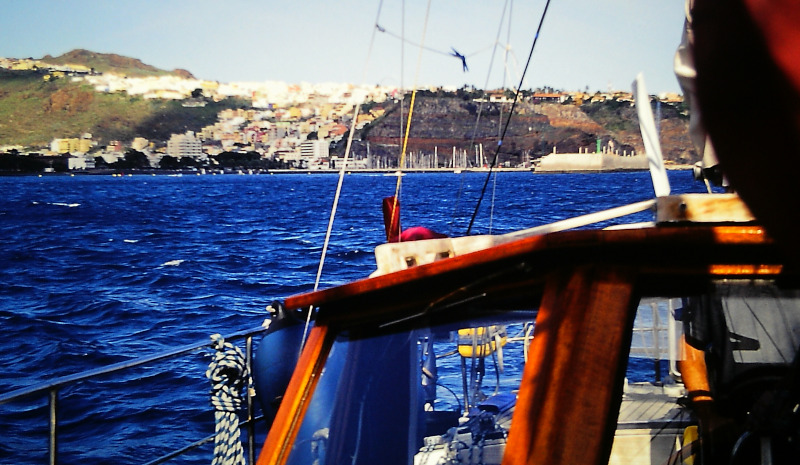
La Gomera is a comparable green island. Damp fog from the sea gets caught in the forests and provides freshness and wetness. I would like to explore more than just San Sebastian. But there’s no time for that. In the afternoon we change the Genoa for the trade wind sail.
San Sebastian also has great taverns, where we spend another sociable evening with a vino tinto. Later we are invited by other German sailors to the yacht and chat a little there. The main topic is how to get weather charts during the crossing in the middle of the Atlantic Ocean. Karsten will try it as former radio operator of the GDR trade shipping company with the weather plotter by radio call.
The morning is spent shopping. Fresh produce should be on board. Already in Tenerife, I bought a piece of fishing net with Karsten that is stretched on the ceiling in a salon corner. On it, bananas, apples and other vegetables are stored. Around noon, we call up a weather map in the harbour office. The wave is good, the wind is favourable, we are ready to sail.
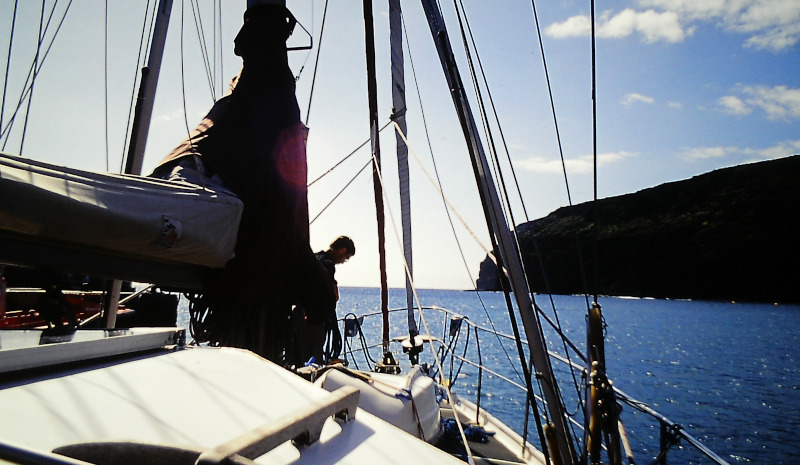
In the early afternoon we set out on the „tracks“ of Columbus! Course – Sao Vicente, Cape Verde. Immediately after leaving the harbour we set the trade wind sail. This „butterfly“ on the forestay is now supposed to pull us across the Atlantic most days. It is a relatively easy route. Among skippers, people often say, „if you throw a bundle of straw into the Atlantic Ocean near La Gomera, it will arrive safely in the Caribbean a few weeks later“. The trade route is therefore often used for a trip across the Atlantic from the end of November onwards – after the hurricane season has come to an end in the Caribbean.
The first afternoon I sit in the sun too long. Or drink too little. Or didn’t eat enough. Probably all of it. Anyway, I don’t feel very well towards evening. If nothing else happens, my stomach gets a little tight. But that changes quickly to the positive, after I’ve moved into the shadows a bit and drank well again. No seasickness. That was the only small weakness on the trip.
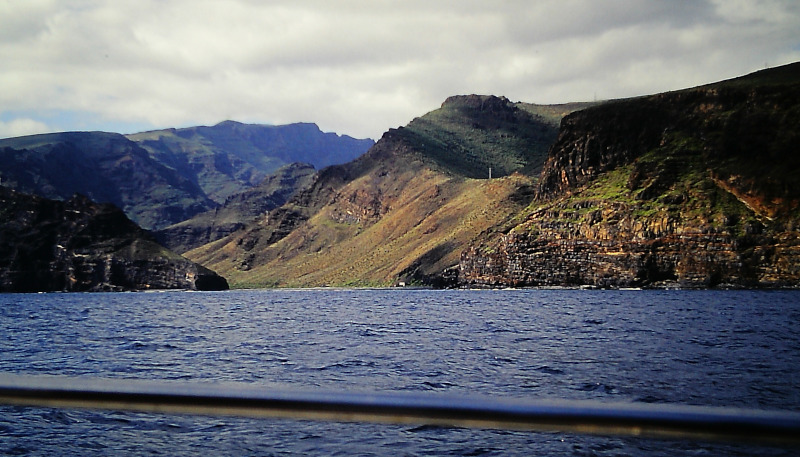
We’ll set up guard duty for the night. Each of us takes 3 hours to complete. From 2100 to midnight, from midnight to 0300, the next one until 0600 and then the first one again – until the others are up. That’s usually between 7 and 8, and we’re under a wind vane. The watchman’s first task is to keep a lookout because of the possibility of encountering other vessels, or floating containers, or whales. And of course, whether everything else is okay, the course is still right, the weather changes, etc. I have a small world receiver with me and then sometimes I look for Deutsche Welle to listen to the news. So I’m not completely uninformed about what’s happening in the world and can contribute to the breakfast conversation.
We’re travelling at 5-6 knots. The course is slightly east of the planned one, which is not a problem as the prevailing winds tend to push us in the opposite direction anyway.
Two nights later this happens almost by itself. The midday cutlery shows us that we are practically back on course.
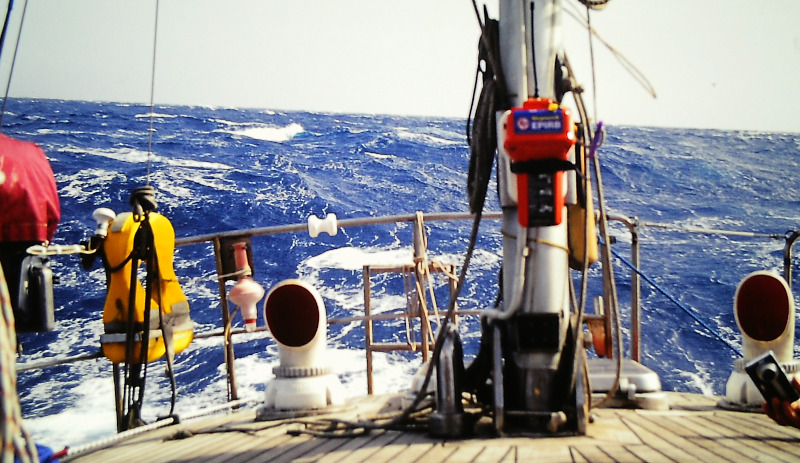
Karsten has taken over the cooking. For the whole time. He also cooks in 7-8 Beaufort wind forces, strapped to the stove. That I’m a vegetarian is fine with him. The dishes are simple anyway, there’s the same thing every four days. I have come to terms with it, but towards the end I am fed up with the monotony. Is that seafaring romance?
Later on I hear from other yachties what there is to eat and how some of the smutjes put together real delicacies. I get a little envious.
My task will be to bake a loaf of bread every 3 days after our supplies are exhausted. My grandpa and my mother were bakers. I never really learned such things practically, but I have copied some of the steps and I succeed well. It’s fun to stand below deck in the constantly swaying boat, kneading dough and then pushing it into the tube. It tastes good, the crispy result is praised and is well received.
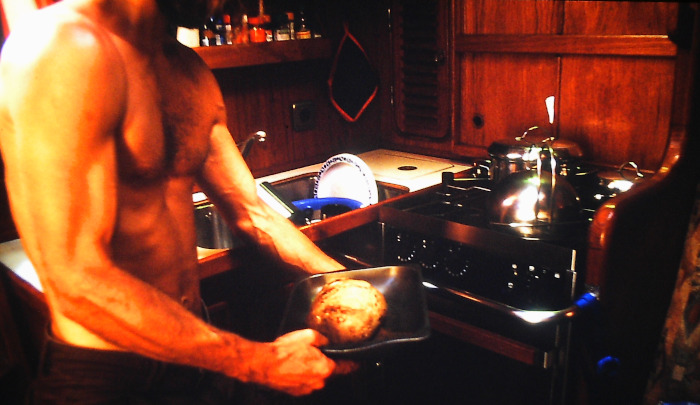
During the night the wind is largely asleep. We are now only sailing at about 3 knots. Since the two gentlemen are under time pressure, that means: Diesel on. This was not my idea of an Atlantic cruise. For one day the diesel murmurs along. It is still about 320 nm to the Cape Verde Islands. At 5 knots sailing about 3 days. Steamer trip with blue sky, sunshine and 1 Beaufort wind . Best holiday weather. I spend the day reading and looking around. Many people think that such a sea voyage becomes boring very quickly. Always only water, clouds and blue sky. For me it is not like that at all. I see constantly changing landscapes out there – mountains, valleys, sometimes with spray, sometimes with jumping fish, cloud pictures in always changing shapes and colours. Even the sea is not just blue or green – the colours are permanently changing.
In the afternoon a catamaran catches up. The double hull boats are faster than us, even in light winds. I am always the first to discover other vehicles. Because my eyes are usually hanging out somewhere on the horizon anyway.
Today we also run out of the last fresh vegetables. From tomorrow on we get canned food.
Since the Auto-Pilot is no longer reliable, we steer by hand during the night. At least there is some feeling for the sea again. Over the wheel the Atlantic gives me a glimpse of its power. One hand at the wheel, I sit nestled in the corner of the cockpit and look now and then at the compass in front of the steering column. However, I always have to stretch myself a little. Soon I found an alternative – a bearing over the backstay and a prominent constellation above me. This works best from my comfortable sitting position. Every 15-20 minutes I stretch myself up and have a look around. On this occasion I now also control the course on the compass. The nights are pretty cool. During the day only with t-shirt and short trousers, at night I wear long trousers, sweater and the jacket from the oilskin. Around my neck hangs my headlamp*, so that I have a lamp for deck work in case of emergency, even without the working light on the main mast. The air is quite dry and a bit dusty despite the sea around us. The wind blows from northeast and brings Sahara dust.
The next day the wind comes back. Under the trade wind sail we are again sailing at 5-6 knots. Finally, the constant hum of the diesel no longer disturbs the peace at sea. Probably we will reach Sao Vicente tomorrow evening.
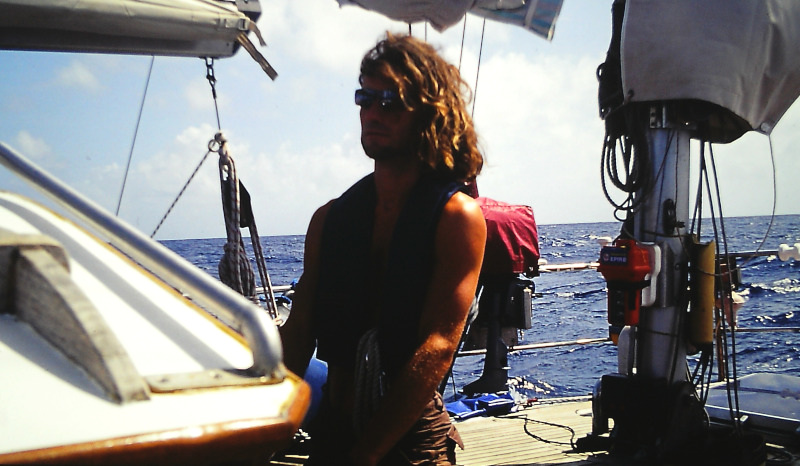
The sea now pushes from astern with waves running in the same direction. The wind vane control doesn’t really follow this. We take turns steering by hand again. With the wave of 3-4 m, the stern is lifted several times and then inserted a bit laterally under the impression of the next wave. Some particularly high waves then cause an involuntary shower over the cockpit. It is really fun to steer in such a way that the course is kept, the sails are well set and still the waves are steered out to avoid the showers. As a helmsman, you have to keep an eye on everything – course, sails, waves, position… I like it and I can sit on the helm for hours. Karsten relieves me from time to time, but I spend most of the day at the helm.
Towards evening the sun sinks in front of us. The sky is a glittering band from southwest to northeast. Cape Verde should appear somewhere ahead. But unfortunately, nothing can be seen. It is said that Columbus drove past the Cape Verde Islands without seeing them. If the situation on his journey was similar, I can well imagine – I don’t see anything either. Only when the sun has disappeared behind the horizon do the islands appear in front of us. And that already quite close. Together with Klaus, the skipper, I plan the approach. I would like to gain as much experience as possible and get as much navigational practice as possible.
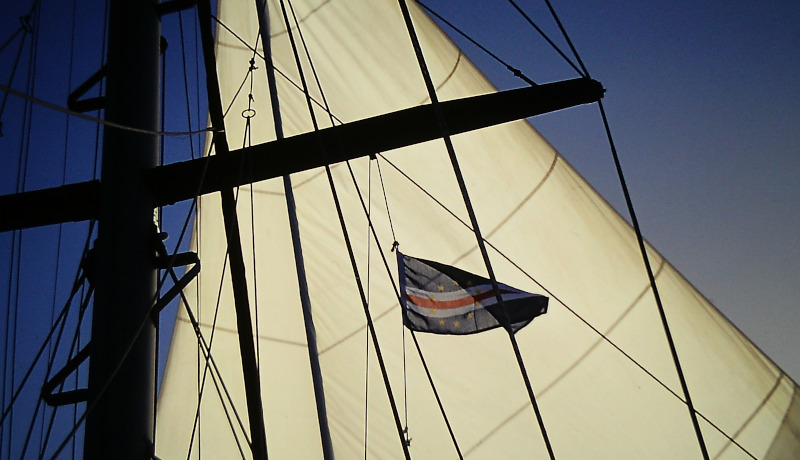
In order to reach the harbour bay of Mindelo on Sao Vicente, we first have to sail around a promontory and then pass a narrow passage with a rocky ridge. Single beacons appear in the incoming darkness. I take the stopwatch and try to identify them by the identification according to the sea chart. A nice exercise, that brings variety to the daily life on board. In the bay we can then navigate relatively freely. Mindelo does not offer a marina for yachties, but only a big anchorage in front of the „Seaside Promenade“. (In the meantime, however, there is a marina). Around 2130 the anchor drops on this 2nd December.
Today, after 7 days at sea, shore leave is announced. For this we have to launch the hard shell dinghy from the forecastle. Half an hour later we motor to the shore. There are already some dinghies from the other yachts. Local youths are loitering around. They earn a few Euros by watching over the dinghis. That means „actively watching out“ – they also use them to quickly transfer crew members of other boats who don’t have a dinghy at the moment. They have to buy the fuel for the trips themselves from the „fee“ they take. After some initial mistrust we come to the conclusion that they do this very reliably.
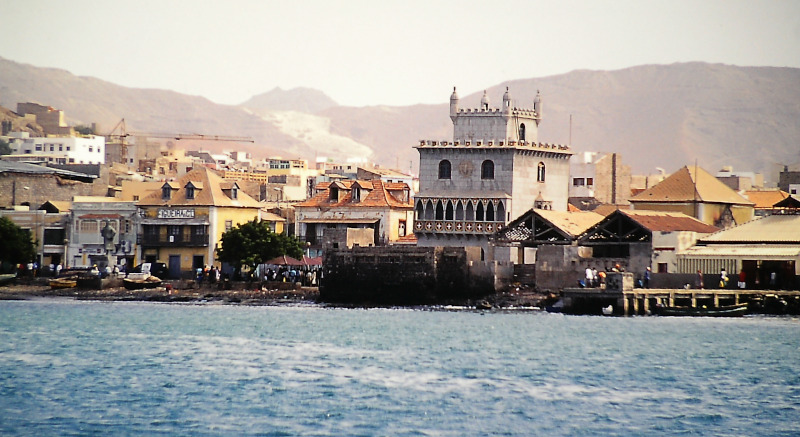
First you go to the „clearing in“, i.e. to customs and immigration. We find these together with other yachties in the industrial harbour. Immediately we get the entry and exit stamp for the day after next, then we don’t need to go there again.
During the sightseeing tour of the city, we are mainly looking for shopping facilities and restaurants for a varied meal. Also a shower would not be bad. We are kept short of drinking water on board. Showering is possible in the cockpit, but as there are no more possibilities to store good water for the time being, we were not allowed to waste anything for „whole body hygiene“. I am on the road with Karsten again and we look for a nice restaurant. When Karsten accidentally gets into the personal toilet, he discovers a shower there! After a friendly request we get the permission to use it. Finally a fresh body feeling again without sweat and salt! Of course there is a proper tip for that.
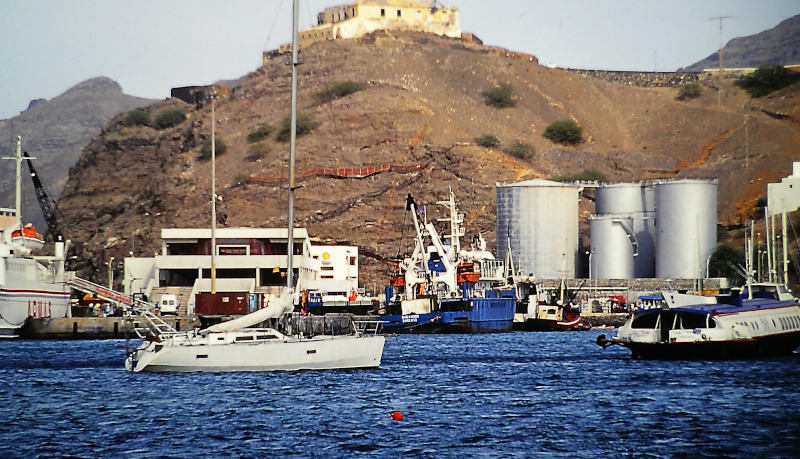
In the evening we all visit another restaurant together. There they offer live music. There are different styles of music known from Cape Verde, some with Portuguese influence, some others. The Morna is known as „Cape Verde Blues“, a slow music in minor keys. We suspect that our musical frame went in this direction.
The next day I am busy shopping again with Karsten. As there are no footbridges and also no „delivery service“ like in Tenerife, I empty my big backpack and we go to the discounter near the shore road. Beside fresh goods, there are specially canned food with vegetables on board. Then we first have to do two hours. The canned goods have to be soaked in sea water. Then we brush the labels off and rewrite them with Edding. This is to prevent cockroach eggs from coming on board, which are often hidden behind labels.
We spend the evening at the Clubo Nautico. There was live music again, but this time from a rock band. The audience consists of locals, but mainly there were other yacht crews in the club. We hear that there is also a shower possibility here, but it is much less comfortable than our restaurant shower.
The next morning we stow the newly bought food. Klaus chugs with the dinghy through the bay and inquires about the possibilities for bunkering diesel. There is a gas station to which we can drive over. But first we have a problem. The anchor cannot be lifted. A dive in the relatively shallow bay shows that it got caught in an old anchor chain running over the ground. Klaus goes down again and after some minutes the anchor is clear. Then we go over to the gas station and fill the tanks.
We are now ready to leave. Ahead of us are about 2100 nm to our destination on the other side of the Atlantic – the island of Tobago in the Caribbean. On our sea chart I have drawn a straight course line with about west-southwest. Every noon we now have the „lunch cutlery“, a current location with entry in the nautical chart. However, quite simply by GPS reading. The skipper claims to have a sextant on board and we can really work with it. I’m very interested in it and have already taken a book on astro-navigation from the on-board library. But day after day Klaus postpones the search for the sextant, so that more than talk about the possibility does not come about. Presumably he has never used this himself seriously and does not want to admit his ignorance about it now.
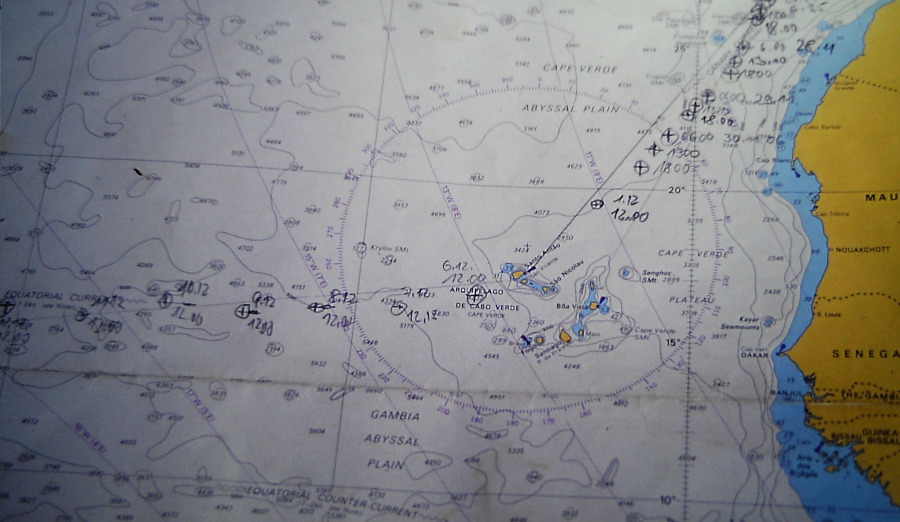
During the nights I am increasingly fascinated by the spectacular starry sky. I have never seen so many stars at once. On land they are outshone by the lights of the cities. Here, at sea and in the darkness, even smaller or more distant stars can penetrate with their light and the effect is incredible. I regret that I do not have a star chart and know so few constellations. My father used to tell me sometimes stories about Kastor and Pollux and other constellations, but little of it stuck. And the laptop with the Linux program „Stellarium„, which offers a planetarium that can be adapted to practically any place on earth, I did not take with me on the sea voyage.
In addition there is a „sea of stars“. Where the bow wave breaks the water and in the swirls of the wake a part of the plankton reacts with phosphorescent phenomena, so that also in the water a real „star train“ accompanies our ship. In the ears there is endless noise, sometimes stronger, sometimes quieter. Below deck, especially in my bow bunk, there is no wind noise and the gurgling of the bow wave and the wake penetrates the hull. In addition, there are individual groans and moans from the masts and rigging. This is the eternal symphony of the sea.
During the morning walk over deck we find now more and more often „flying fish“. Unfortunately they do not tolerate the false landing on board and we can only remove the bodies. Seldom during the day we find the unfortunate flyers in time to release them alive back into their wet element.

But this is also another sea – cinema event: Watching flying fish. These rise relatively horizontally from the waves, always in a shoal, and then sail 20 … 30 meters above the water surface. This is made possible by elongated and stiffened pectoral fins that protrude like wings. However, they are not really suitable as an extension of the menu. There is not much to it and the body is more cartilaginous.
A new task is added. As we are now sailing westwards, the clock is shifted by one hour at each further 15° West of Greenwich. Our „midday cutlery“ gives us the ship’s position 15° 22.86 N 33° 23.90 W on 10.12. 33° West means a time difference of -2 hours to UTC. In the afternoon Karsten writes in his small private logbook: „This afternoon 1492 nautical miles to Tobago. In 1492 Columbus discovered America“.
On 13 December the wind falls asleep again. So that the gentlemen can still manage their Christmas date, we have been running under the machine all day since 0500. After the noon cutlery we are still 40 nautical miles short, then we have half the distance to Tobago. This happens the following night. About 0200 on 14.12., i.e. for us in the middle of the Atlantic, there is the first sighting of another boat, only about 2.5 nautical miles away. A catamaran westwards, a small white light on the huge ocean. Actually we had expected many more encounters, because at the end of November the ARC, the Atlantic Rally for Cruisers, starts on Gran Canaria. This is an opportunity for relatively inexperienced blue-water sailors to sail across the Atlantic in a large field of several hundred yachts and to know other boats nearby in case of emergency.
However, our course after the excursion to the Cape Verde Islands is probably a little too south, so that we do not affect the main field at all. Only the faster catamarans get a wide curve occasionally, before they set the course into the Caribbean. In addition, our range of vision is not too big because of the curvature of the earth on the Atlantic. From the deck we can see other boats, which are also not very high, only up to about 5 nm distance. Maybe we are not as alone as it seems – the others are only sailing behind the horizon? Only masts and superstructures, or the significantly higher freighters of the large shipping companies we see over longer distances – but despite crossing the important shipping routes from Europe to South America we still don’t see any other vehicles.
And the diesel is still running. Only in the late morning the wind freshens up enough for us to set the blister (a light wind sail). It floats like a huge red and white bubble in front of the main mast. Since the main mast is extended like a spinnaker and needs wind in a narrow angle from astern, we steer by hand again. The wind steering system is too sluggish for this, so that the blister would collapse in case of a sideways wind or a strongly rolling ship and we lose speed every time until it is filled with wind again. So we now reach 6 to over 7 knots. But this is also the greatest pleasure for me – now under hand steering, with wind in the sail, I feel the connection with wind and sea in a special way and I am happy how we are slowly moving forward towards America with the help of the „elements“. Since we have to concentrate on the helm-wheel and constantly watch the waves, course and wind changes, the watch changes for the night are reduced to 2 hours. Sleeping or dozing on deck is over for the time of the watch. But that doesn’t matter, as we as helmsmen have a lot to do and stay awake by ourselves.
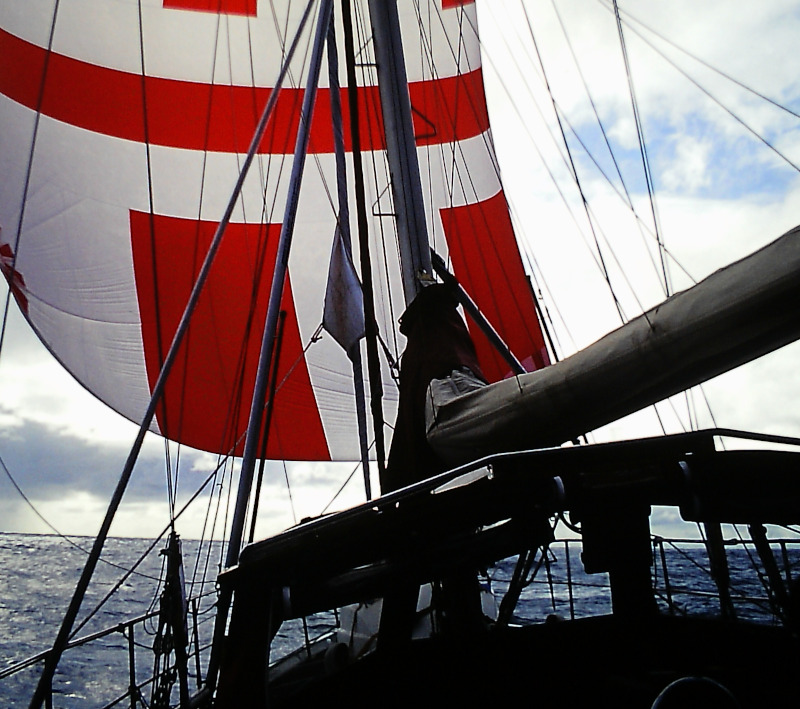
On 15 December the fast ride is over for the time being. We ride under diesel, because the wind is no longer merciful to us. But the supplies are already shrinking considerably, we probably only have fuel for 24 hours. Tobago lies 787 nautical miles ahead of us.
Towards evening the wind returns and we set the blister again. But the joy of 6.8 knots speed would not be long. At half past eight a storm is coming up. The blister was quickly recovered and the cutter jib to starboard was removed. When later the downhaul of the spinnaker halyard broke, our idea for this night was finished, to extend the Genoa additionally to port and to continue with reduced trade wind sails. Because of the strong gusts we weathered a restless night with only the cutter jib at 3 to 4 knots.
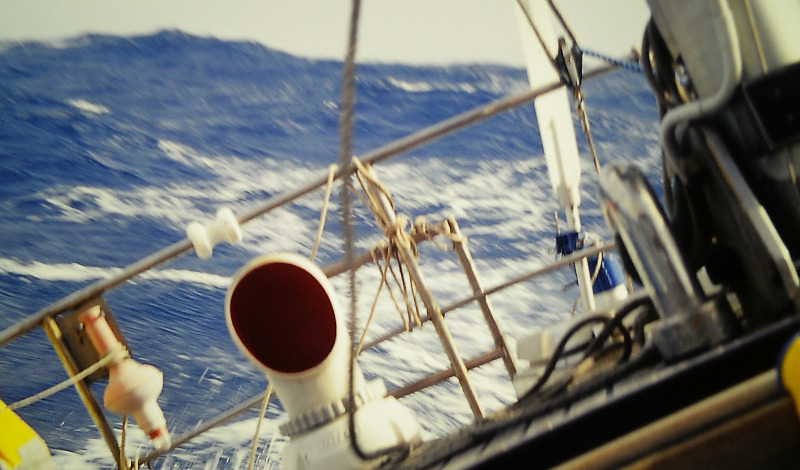
The next morning the wind calmed down. Now the repair is pending. The insertion of the new case with the help of the loose end of the old one goes wrong of course. So Karsten climbs into the mast secured with the main halyard and threads the new halyard by hand over the pulley.
As far as everything is clear, the trade wind sail is used and we finally rush westwards again with 6 knots.
I’m on early duty from 0600 till the others are up. It is a beautiful sunrise and the sky changes the night grey for a strong blue. The wind has died down a bit, so we are now only sailing at 5 to 5.5 knots. From southwest a small swarm of 6 or 7 jumping tuners is coming towards us. They move towards us almost like dolphins. Only 20 m away from the boat they turn east and pass us with long jumps. Our midday cutlery gives us a position: 12° 53,24 N 51° 32,00 W.
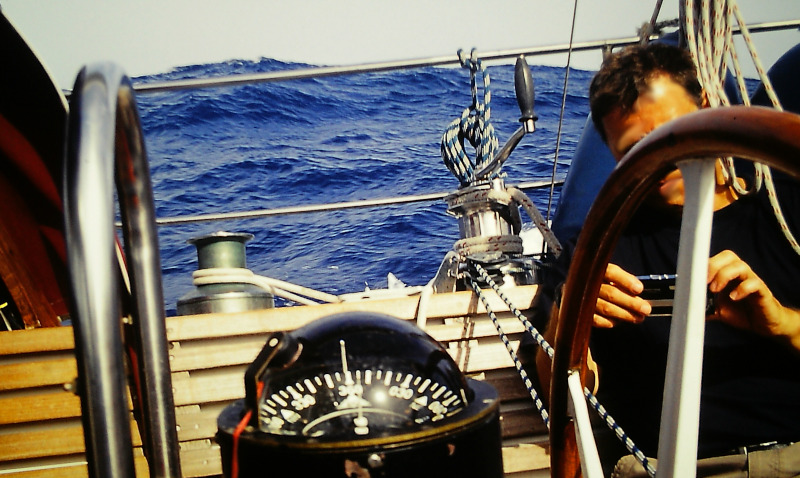
Since the morning of 18 December, the speed has increased to 6 knots, in peaks even to 7.5 knots. I am torn. On the one hand, the cruise is really fun and everything is going well, on the other hand, the end of the trip is approaching. I have been on board for almost 5 weeks now, I have settled in and enjoy every minute. O.k., that the sextant will see the light of the Atlantic sky again, becomes more and more improbable. So the chances to learn something new are dwindling. For Klaus and Karsten it is now only about arriving and the Christmas reunion with their wives. I don’t really care about that, I care about sailing. Expected arrival date is now December 21. There are still 400 nautical miles separating us from Tobago.
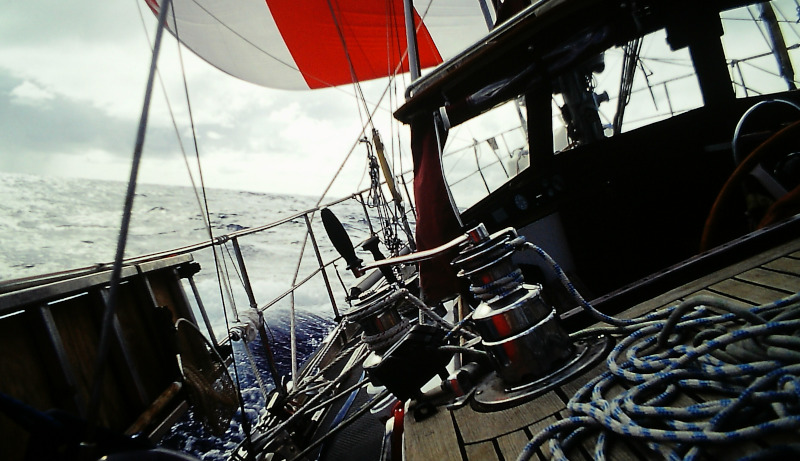
Until about 0530 on 19.12. the rush went on, partly with peaks even up to 8.5 knots. Then this time the downhaul of the port spi boom broke. So, trade sails furled, the cutter jib furled and a repair. Fortunately without mast climbing, the rest is stable enough this time to thread the new downhaul. In the late morning the wind pushes us forward again with 6 to 7 knots under trade sails.
The morning of 20.12. brings lower speeds of 4.5 to 5 knots and the second encounter since Cape Verde – a freighter overtakes us on starboard approx. 2 nm ahead. In addition, the first land based seabirds appear. At noon it is still 125 nm to our destination.
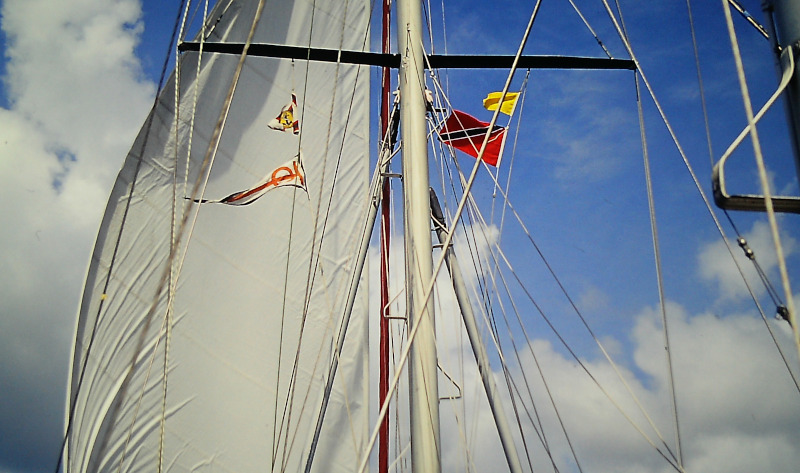
The morning of 21 December brings the first sight of land – Tobago ahead! Around 1100 (UTC -4h) we start our approach to the harbour bay of Scarborough, the capital of the smaller sub island Tobago. Under the starboard spreader the guest country flag and the customs pennant are fluttering. The attempts of Karsten as an old marine radio operator to contact „Traffic Control Tobago“ fail. Nobody cares if we come or not. But we feel almost like Columbus, who a few centuries earlier believed that he would approach India on the western route. There is already a little bit of a festive mood in the air about having now crossed the Atlantic and reached the Caribbean.
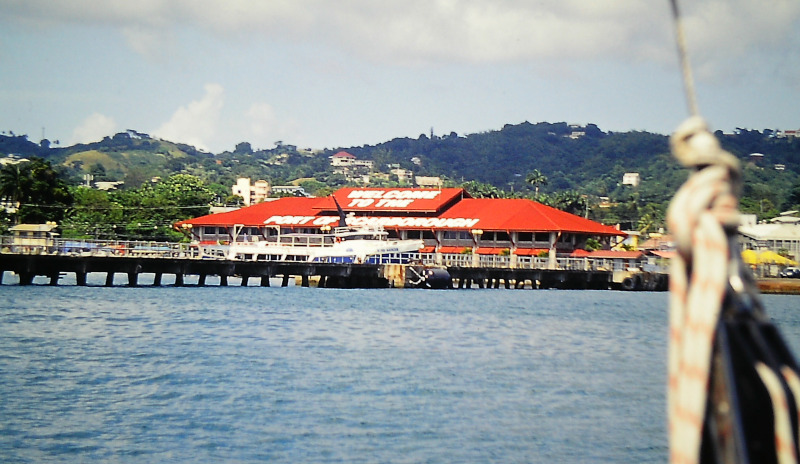
Slowly and meanwhile under diesel the Pronto pushes itself into the Scarborough Bay. Four or five other yachts are already at anchor. On port side a rusty wreck seems to lie on the side, frequently washed over by the surf. Later it becomes apparent from land that it is only a very regularly shaped rock. Around 1245 we found our place, far enough from the shore and with enough space to the other yachts to be able to swim freely. The anchor falls, my sea journey is unfortunately thereby to end. We still clear on Tobago on the same day and after a last night on board the Pronto Klaus brings me with the dinghy to the shore. Karsten has already flown on the evening before with one of the „Islandhopper“ – planes. I have to get at least a pro forma ticket for my departure from TT. Then I have to go with the skipper to the immigration office again and get signed out of the board documents. Otherwise there could be problems for the skipper, because he smuggled illegal immigrants to TT.
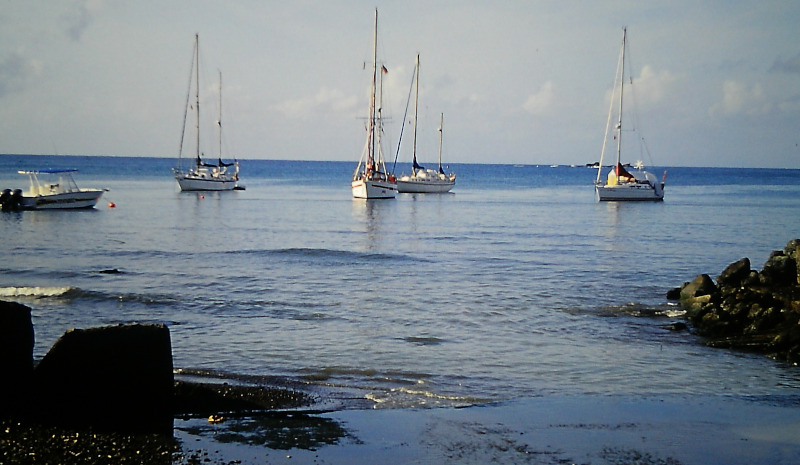
After that, I’ll look for quarters. Tobago is in the Christmas spirit. At the roadsides there are partly waist-high boxes, from which Christmas reggae drone. Next to them, decorated palm trees and light chain constructions in the 24°C hot sun announce the approaching Christmas.
Reading and sharing
Was it a pleasure for you to read this article? Then I would be happy if you share the link to the post in your social networks and let your friends share this pleasure, too! Thank you!

